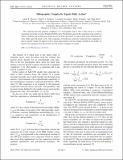Holographic Complexity Equals Bulk Action?
Author(s)
Brown, Adam R.; Susskind, Leonard; Swingle, Brian; Zhao, Ying; Roberts, Daniel Adam
DownloadPhysRevLett.116.191301.pdf (1.066Mb)
PUBLISHER_POLICY
Publisher Policy
Article is made available in accordance with the publisher's policy and may be subject to US copyright law. Please refer to the publisher's site for terms of use.
Terms of use
Metadata
Show full item recordAbstract
We conjecture that the quantum complexity of a holographic state is dual to the action of a certain spacetime region that we call a Wheeler-DeWitt patch. We illustrate and test the conjecture in the context of neutral, charged, and rotating black holes in anti–de Sitter spacetime, as well as black holes perturbed with static shells and with shock waves. This conjecture evolved from a previous conjecture that complexity is dual to spatial volume, but appears to be a major improvement over the original. In light of our results, we discuss the hypothesis that black holes are the fastest computers in nature.
Date issued
2016-05Department
Massachusetts Institute of Technology. Center for Theoretical Physics; Massachusetts Institute of Technology. Department of PhysicsJournal
Physical Review Letters
Publisher
American Physical Society
Citation
Brown, Adam R., Daniel A. Roberts, Leonard Susskind, Brian Swingle, and Ying Zhao. “Holographic Complexity Equals Bulk Action?” Physical Review Letters 116, no. 19 (May 9, 2016). © 2016 American Physical Society
Version: Final published version
ISSN
0031-9007
1079-7114